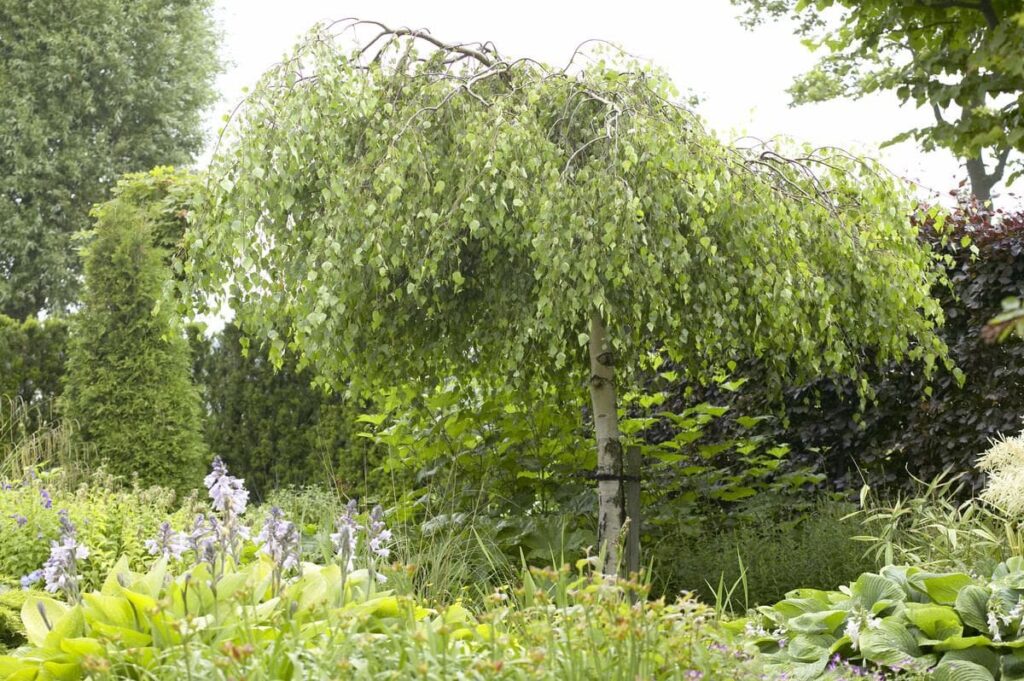Introduction
The Weeping Birch (Betula pendula) is a stunning and graceful tree known for its delicate, cascading branches and striking white bark. This elegant tree can add a touch of charm and sophistication to any garden or landscape. With proper care and attention, the Weeping Birch can thrive for many years, providing beauty and shade. This comprehensive guide will take you through the steps of planting and nurturing a Weeping Birch, ensuring it grows healthy and strong.
Understanding the Weeping Birch
The Weeping Birch is native to Europe and parts of Asia, and it is well-adapted to a range of climates. It is particularly popular in temperate regions due to its ability to withstand cold winters. The tree typically reaches a height of 30 to 40 feet, with a spread of 20 to 30 feet. Its distinctive, drooping branches and white bark make it a focal point in any landscape. The tree’s leaves are triangular and serrated, turning a beautiful yellow in the fall.
Selecting the Right Location
Choosing the right location for your Weeping Birch is crucial for its health and growth. Here are some factors to consider:
- Sunlight: Weeping Birches thrive in full sun to partial shade. They need at least 6 hours of direct sunlight daily.
- Soil: The tree prefers well-drained, moist soil. Sandy or loamy soils are ideal. Ensure the soil is rich in organic matter.
- Space: Ensure there is enough space for the tree to grow to its full size. Planting too close to buildings or other trees can hinder its growth.
- Water Access: Weeping Birches require consistent moisture, so having a water source nearby can be beneficial.
Planting Your Weeping Birch
Planting a Weeping Birch involves several steps to ensure the tree establishes well in its new environment:
- Digging the Hole: Dig a hole that is twice the width of the root ball and the same depth. This allows the roots to spread easily.
- Preparing the Soil: Mix the excavated soil with compost or organic matter to improve fertility and drainage.
- Planting the Tree: Place the tree in the hole, ensuring the root flare is at ground level. Backfill with the soil mixture, gently tamping down to remove air pockets.
- Watering: Water the tree thoroughly after planting. This helps settle the soil and provides moisture to the roots.
- Mulching: Apply a layer of mulch around the base of the tree to retain moisture and suppress weeds. Keep the mulch away from the trunk to prevent rot.
Caring for Your Weeping Birch
Proper care is essential for the healthy growth of your Weeping Birch. Here are some key aspects to focus on:
- Watering: Weeping Birches need regular watering, especially during dry periods. Aim to keep the soil consistently moist but not waterlogged.
- Fertilizing: Feed the tree with a balanced, slow-release fertilizer in early spring. Avoid high-nitrogen fertilizers as they can promote excessive leaf growth at the expense of root development.
- Pruning: Prune the tree in late winter or early spring before new growth begins. Remove dead, damaged, or crossing branches to maintain the tree’s shape and health. Avoid heavy pruning, as this can stress the tree.
- Pest and Disease Control: Watch for common pests such as aphids, birch leaf miners, and bronze birch borers. Use appropriate treatments if infestations occur. Ensure good air circulation and proper watering to prevent fungal diseases.
Dealing with Common Problems
Despite your best efforts, your Weeping Birch may encounter some issues. Here are common problems and how to address them:
- Leaf Yellowing: This can be a sign of drought stress, poor soil, or pest infestations. Ensure the tree is adequately watered and check for pests.
- Bark Damage: Physical damage to the bark can be caused by animals, lawn equipment, or extreme weather. Protect the trunk with a tree guard if necessary.
- Root Rot: Overwatering or poor drainage can lead to root rot. Ensure the soil is well-drained and avoid overwatering.
Enhancing the Landscape
Weeping Birches are not only beautiful but also versatile. Here are some ideas to enhance your landscape with this elegant tree:
- Accent Tree: Use the Weeping Birch as a focal point in your garden. Its unique shape and bark make it stand out.
- Shade Tree: Plant it in areas where you need shade. Its canopy provides excellent cover.
- Water Feature Companion: Weeping Birches look stunning near ponds, streams, or other water features. The reflection of the tree in the water adds to its beauty.
- Mixed Plantings: Combine the Weeping Birch with other trees and shrubs to create a diverse and visually appealing landscape. Consider companion plants that thrive in similar conditions.
Conclusion
The Weeping Birch is a timeless and elegant addition to any garden or landscape. With its graceful branches, striking white bark, and vibrant fall foliage, it offers year-round beauty. By following the steps outlined in this guide, you can ensure your Weeping Birch thrives, providing enjoyment for many years to come. Remember to choose the right location, plant with care, and provide consistent maintenance. With proper nurturing, your Weeping Birch will grow into a majestic tree that enhances the beauty of your outdoor space.















